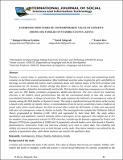| dc.description.abstract | Chastity is central value in sustaining moral standards related to sexual actions and maintaining family constancy to facilitate societal perpetuation. Most traditional societies value virginity for girls, and fidelity in marriage, as men uphold self-control. Each community deals with chastity issues, in the form of taboos and chastisement for the deviants. Studies divulge that failure to observe key sexual values, has affected an enormous number of families internationally and locally. This has led to shattering consequences on the family unit, such as; HIV &Aids, premature pregnancies, deaths and divorces. The core concern for numerous churches is the modern moral permissiveness has left the conventional family of man and woman an overwhelmed institution, in danger of extinction. The study examines the indicators of contemporary value of chastity among the SDA families in Nyamira County. This study is significant because the future of the society is based on the stability of a family. Hence, recommendations from the survey would help create a tradition on sexual value which would advance the field of sexual ethics within the SDA family, to help curb associated indicators of contemporary value of chastity on family. The investigation has adopted the Utilitarian Ethical Theory propounded by Bentham (1748- 1832) and expounded by John Stuat Mill. The study utilizes quantitative and qualitative research methods within a descriptive survey approach. The sample size of 375 lay members, from purposively selected 10 SDA churches, considering the formula suggested by Krejcie and Morgan (1970) from a population of 15000 and 15 purposively selected leaders were interviewed in Nyamira.Questionnaires, observation FGDs and interview schedule were used to collect data. The reliability and validity of research instruments were arrived through a pilot study. Descriptive statistics was utilized for the analysis of quantitative data, while theme analysis was used for the qualitative data. | en |
